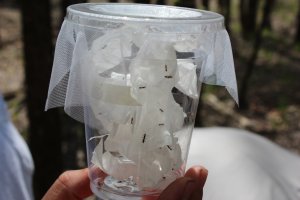AgEBB-MU CAFNR Extension
Green Horizons
Volume 21, Number 2
Spring 2017
Forest Health
SWAT Team of Wasps Sent To Help Save Our Ash Trees
By Sarah Phipps | Missouri Department of Agriculture
Tiny wasps swarm inside a clear plastic cup eager for release. A few drops of honey placed on the netting that enclosed the cups have provisioned them along their FedEx journey. These wasps are elite marksmen (...or in this case "markswomen") that have been brought to our state with a specialized role: seek out and find a certain tree-invading pest, the emerald ash borer (EAB).
In the early 2000's, when EAB was decimating millions of ash trees in southeastern Michigan, it seemed like a distant worry for Missouri. Flash forward to today where the green menace has set up shop in 34 Missouri counties and the City of St. Louis.
Controlling and managing for an invasive pest can be a challenging task, especially when the insect is fully established in an area prior to detection. To help counter the impact, natural enemies of EAB from the emerald ash borer's native range in Asia have been introduced into the United States to serve as a biological control.
The three biocontrol agents are a team of parasitoid wasps whose offspring consume the eggs and larvae of EAB. These stingless wasps are harmless to humans and tiny; the largest species is the size of a mosquito. The egg parasitoid, Oobius agrili, locates an EAB egg in the bark crevices. The wasp then will insert a single egg into the EAB egg, parasitizing them before given the opportunity to hatch. The two larval parasitoids are Tetrastichus planipennisi and Spathius agrili. Females walk along the bark to detect vibrations from feeding EAB larvae. Then they lay multiple eggs on or in the EAB larvae and consume the EAB larvae in seven to ten days.
Since 2012, the Missouri Department of Agriculture (MDA), in cooperation with the U.S. Department of Agriculture (USDA), has released over 197,000 wasps at 17 sites in Clay, Platte, Pulaski, St. Charles and Wayne Counties, and the City of St. Louis. The wasps are provided by the USDA-APHIS Biocontrol Production Facility in Brighton, Mich. At least 21 other states with EAB have released parasitoid wasps thus far.
An environmental assessment of the three parasitioid wasps was completed by the USDA to evaluate the risk of non-target damage. To test for specificity, the parasitic wasps were offered insects that are related to EAB or share the same habitat or environmental niche. The USDA concluded that the three selected parasitic wasps are acceptably host-specific and are not expected to attack other insect species besides EAB with the exception of some incidental attack of other wood-boring beetles in the same genus as EAB (Agrilus).
To survey for establishment of the parasitoids, wasps were collected by means of yellow pan traps which were adhered to the side of trees in areas where wasps were released from previous years. The color yellow is used since many adult bee and wasp species are attracted to this color. MDA recently received confirmation that
 |
Biocontrol release of parasitoid wasps in |
T. planipennisi, has successfully established in Wayne County.
These little wasps are not a silver bullet for controlling EAB, but they serve as a tool to help in the long-term management strategy to lessen the impact of EAB. With the prospect of losing many more of our ash trees to EAB, it is good to have as many tools as possible. However, educating the public is the most important strategy since humans are the ones most responsible for the spread of EAB.
People can help prevent pests from moving and prolong the introduction of EAB to areas of the state not yet infested by following some simple practices like burning local firewood and purchasing wood for woodworking projects from a local source. Scientists recommend not moving untreated wood farther than 50 miles from where it was harvested, to prevent long distance movement of forest pests. It may be too late to prevent EAB from getting into our state, but it is not too late to prevent other invasive pests from taking residence in Missouri.
FOREST HEALTH More information about Missouri's Emerald Ash Borer Biocontrol Program can be found at:
http://extension.missouri.edu/treepests/documents/FAQbiocontrol.pdf
https://www.aphis.usda.gov/publications/plant_health/2014/faq_eab_biocontrol.pdf
